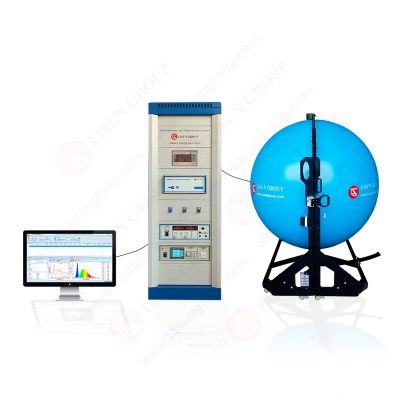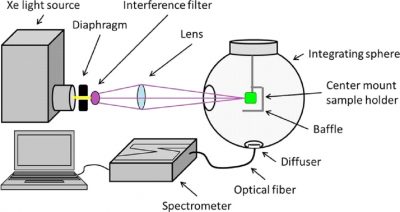LISUN has been manufacturing integrating spheres for many years. Our Integrating Spheres product line offers a fantastic selection capable of measuring watts, lumens, candela, lux, joules, W/cm2 etc. LISUN integrating sphere-based systems support the measurements from various light sources.

LPCE-2(LMS-9000C)High Precision Spectroradiometer Integrating Spheres System
These light sources include lasers, fiber optic light guides, endoscopes, tiny seeds such as miniature halogen lamps, LEDs, neon lamps, and more comprehensive sources such as LED modules, flashlights, automotive lamps, etc.
An integrating sphere (Ulbricht sphere) is an optical instrument consisting of a hollow spherical cavity with its interior covered with a white reflective coating. It is known best for its diffusing effect and uniform coating. Integrating the sphere is one of the essential tools for light measurement. Integrating spheres in illumination is best for measuring the light intensity.
Integrating spheres produce an illumination that possesses extremely uniform radiance and irradiance. An integrating sphere is defined as a hollow spherical shell coated on the inside with a highly reflecting diffuse coating.
Integrating spheres capture the light falling on the surface and scatter it in multiple directions. Several lumens, efficiency flow, and color are other significant characteristics of a lamp that manufacturers find essential.
While doing measurement with an integrating sphere, the light intensity is 1/100 to 1/1000 as compared with measuring light received directly by a detector. Thus, the noise level increases when the measurement is performed in the same conditions as when light is received directly by a sensor. To reduce the noise level, we increase the light intensity. This can be achieved by widening the slit on a spectrophotometer.
Generally, the inner wall diameter of integrating spheres used in spectrophotometers is 60 mm. Some integrating spheres have an inner wall diameter of more than 140 mm. These have a smaller aperture ratio and higher diffusion properties. Thus, they are less likely to be affected by the scattering state of the sample.
However, due to the more significant space available in the integrating sphere, the intensity of light incidents on the detector decreases and increases the noise level. The aperture ratio is the total area of the hole concerning the entire area, including the spot on the inner wall of the integrating sphere.

Light measurement using an integrating sphere
LPCE-2(LMS-900C) is a high CCD Spectroradiometer with good precision with a good Integration Sphere Testing System. It is considered best suitable for all luminaires’ photometric and colorimetric measurements. LPCE-2 Integrating Sphere Spectroradiometer LED Testing System is valid for single LEDs and LED lighting products light measurement.

• High Precision CCD Spectroradiometer (LMS-9000C)
• An Optical Fiber (CFO-1.5M)
• Digital Power Meter (LS2050B)
• DC Power source (DC3005)
• AC Power source (LSP-500VARC)
• Integrating Sphere (IS-1.5MA or IS-0.3M)
• A Standard Light Source (SLS-50W and SLS-10W)
• 19 Inch Cabinet (CASE-19IN)
• The whole system adopts an integrated design, space-saving and elegant overall appearance. LISUN owns the design patent for the LPCE-2(LMS-9000C) high precision integrating sphere spectroradiometer system.
• Diameters of 1.5 meters to 2.0 meters can be selected according to the user’s maximum size of the sample.
• The giant integrating sphere is equipped with a cross laser. It is used for the operator to install the sample in the center of the integrating sphere.
• A 0.3-metre small integrating sphere is optional.
• It is used for testing a single LED. The software runs on any Windows system.
• Install the optical fiber. The optical fiber is very fragile. Please take care of it and do not bend it.
• Connect the fiber to the spectroradiometer. The other end goes to the integrating sphere.
• Now, connect the temperature sensor to the spectroradiometer. The sensor goes to the integrating sphere.
• Use the USB cable to connect the spectroradiometer to the computer. A USB cable powers it. So, no need to click any power supply here.
• Connect the communication cable and install the DC power source. Connect the output cable for a DC source.
• Connect the power cord. Connect the communication cable to the communication box.
• Install the AC power source. Connect the output cable to an AC source. Install the driver for the RS232-USB cable.
• Connect the grounding wire to the cabinet. Now, connect the power cord for the cabinet. It needs 220 V power. Turn on the cabinet and all the equipment.
• Install the standard lamp in the center of the sphere. Double click to enter the main software.
• Click on ‘’spectrum calibrate’’.
• No need to ‘’flux calibrate’’. Because the standard lamp is DC, choose DC here.
• Choose the correct COM port for the DC source.
• No need to change the average heating time.
• Set 15 minutes for preheating. Click ‘’Start’’. The DC source outputs constant current automatically.
• The standard lamp is ON now. The software will calibrate automatically after the preheating time.
• Click ‘’OK’’ to save the calibration.
• Now, turn off the assistant lamp and turn on the sample.
An integrating sphere spreads the incoming light in different directions by reflecting the light over the entire surface of the sphere. This feature of an integrating sphere makes it an ideal instrument for multiple applications—for example, laser power, reflectance, flux, and other radiance instruments.
Apart from the advantages of an integrating sphere, there are some disadvantages. The coating gets damaged if the source of light is high-powered. We can not use the damaged layer; it should be changed if we use the sphere again. This is an expensive task. Materials used in this procedure are barium sulphate and magnesium oxide.
Lisun Instruments Limited was found by LISUN GROUP in 2003. LISUN quality system has been strictly certified by ISO9001:2015. As a CIE Membership, LISUN products are designed based on CIE, IEC and other international or national standards. All products passed CE certificate and authenticated by the third party lab.
Our main products are Goniophotometer, Integrating Sphere, Spectroradiometer, Surge Generator, ESD Simulator Guns, EMI Receiver, EMC Test Equipment, Electrical Safety Tester, Environmental Chamber, Temperature Chamber, Climate Chamber, Thermal Chamber, Salt Spray Test, Dust Test Chamber, Waterproof Test, RoHS Test (EDXRF), Glow Wire Test and Needle Flame Test.
Please feel free to contact us if you need any support.
Tech Dep: Service@Lisungroup.com, Cell/WhatsApp:+8615317907381
Sales Dep: Sales@Lisungroup.com, Cell/WhatsApp:+8618117273997
Your email address will not be published. Required fields are marked *